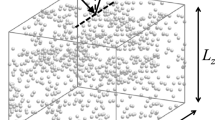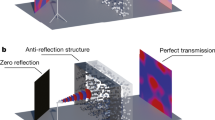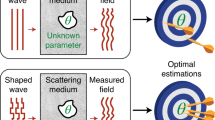Abstract
Random scattering of light in disordered media is an intriguing phenomenon of fundamental relevance to various applications1. Although techniques such as wavefront shaping and transmission matrix measurements2,3 have enabled remarkable progress in advanced imaging concepts4,5,6,7,8,9,10,11, the most successful strategy to obtain clear images through a disordered medium remains the filtering of ballistic light12,13,14. Ballistic photons with a scattering-free propagation are, however, exponentially rare and no known method has been able to increase their proportion. To address these limitations, we introduce and experimentally implement a new set of optical states that we term scattering invariant modes, whose transmitted field pattern is the same, irrespective of whether they scatter through a disordered sample or propagate ballistically through a homogeneous medium. We observe scattering invariant modes that are only weakly attenuated in dense scattering media, and show in simulations that their correlations with the ballistic light can be used to improve imaging inside scattering materials.
This is a preview of subscription content, access via your institution
Access options
Access Nature and 54 other Nature Portfolio journals
Get Nature+, our best-value online-access subscription
$29.99 / 30 days
cancel any time
Subscribe to this journal
Receive 12 print issues and online access
$209.00 per year
only $17.42 per issue
Buy this article
- Purchase on Springer Link
- Instant access to full article PDF
Prices may be subject to local taxes which are calculated during checkout




Similar content being viewed by others
Data availability
The data that underlie the plots within this paper and other findings of this study are available from the corresponding authors on reasonable request.
Code availability
The code used to generate simulated data and plots is available from the corresponding authors on reasonable request.
Change history
26 April 2021
A Correction to this paper has been published: https://doi.org/10.1038/s41566-021-00817-8
References
Johnson, C. & Gabriel, D. Laser Light Scattering (Dover Publications, 2015).
Mosk, A. P., Lagendijk, A., Lerosey, G. & Fink, M. Controlling waves in space and time for imaging and focusing in complex media. Nat. Photon. 6, 283–292 (2012).
Rotter, S. & Gigan, S. Light fields in complex media: mesoscopic scattering meets wave control. Rev. Mod. Phys. 89, 015005 (2017).
Yoon, S. et al. Deep optical imaging within complex scattering media. Nat. Rev. Phys. 2, 141–158 (2020).
Kubby, J., Gigan, S. & Cui, M. (eds) Wavefront Shaping for Biomedical Imaging (Cambridge Univ. Press, 2019).
Bertolotti, J. et al. Non-invasive imaging through opaque scattering layers. Nature 491, 232–234 (2012).
Katz, O., Heidmann, P., Fink, M. & Gigan, S. Non-invasive single-shot imaging through scattering layers and around corners via speckle correlations. Nat. Photon. 8, 784–790 (2014).
Kang, S. et al. High-resolution adaptive optical imaging within thick scattering media using closed-loop accumulation of single scattering. Nat. Commun. 8, 2157 (2017).
Jang, M. et al. Wavefront shaping with disorder-engineered metasurfaces. Nat. Photon. 12, 84–90 (2018).
Horisaki, R., Mori, Y. & Tanida, J. Incoherent light control through scattering media based on machine learning and its application to multiview stereo displays. Opt. Rev. 26, 709–712 (2019).
Badon, A. et al. Distortion matrix concept for deep optical imaging in scattering media. Sci. Adv. 6, eaay7170 (2020).
Wang, L. V. & Wu, H. Biomedical Optics: Principles and Imaging (Wiley, 2007).
Ntziachristos, V. Going deeper than microscopy: the optical imaging frontier in biology. Nat. Methods 7, 603–614 (2010).
Drexler, W. & Fujimoto, J. (eds) Optical Coherence Tomography: Technology and Applications (Springer International Publishing, 2015).
Dorokhov, O. On the coexistence of localized and extended electronic states in the metallic phase. Solid State Commun. 51, 381–384 (1984).
Beenakker, C. W. J. Random-matrix theory of quantum transport. Rev. Mod. Phys. 69, 731–808 (1997).
Pendry, J., MacKinnon, A. & Pretre, A. Maximal fluctuations—a new phenomenon in disordered systems. Phys. A 168, 400–407 (1990).
Akkermans, E. & Montambaux, G. Mesoscopic Physics of Electrons and Photons (Cambridge Univ. Press, 2007).
Pena, A., Girschik, A., Libisch, F., Rotter, S. & Chabanov, A. A. The single-channel regime of transport through random media. Nat. Commun. 5, 3488 (2014).
Davy, M., Shi, Z., Wang, J. & Genack, A. Z. Transmission statistics and focusing in single disordered samples. Opt. Express 21, 10367–10375 (2013).
Miller, D. A. B. Waves, modes, communications and optics. Adv. Opt. Photon. 11, 679–825 (2019).
Vellekoop, I. M. & Mosk, A. P. Universal optimal transmission of light through disordered materials. Phys. Rev. Lett. 101, 120601 (2008).
Hsu, C. W., Liew, S. F., Goetschy, A., Cao, H. & Stone, A. D. Correlation-enhanced control of wave focusing in disordered media. Nat. Phys. 13, 497–502 (2017).
Yu, H. et al. Measuring large optical transmission matrices of disordered media. Phys. Rev. Lett. 111, 153902 (2013).
Kim, M. et al. Maximal energy transport through disordered media with the implementation of transmission eigenchannels. Nat. Photon. 6, 581–585 (2012).
Mello, P., Pereyra, P. & Kumar, N. Macroscopic approach to multichannel disordered conductors. Ann. Phys. 181, 290–317 (1988).
Bosch, J., Goorden, S. A. & Mosk, A. P. Frequency width of open channels in multiple scattering media. Opt. Express 24, 26472 (2016).
Pai, P., Bosch, J. & Mosk, A. P. Optical transmission matrix measurement sampled on a dense hexagonal lattice. OSA Continuum 3, 637–648 (2020).
Forrester, P. J. & Nagao, T. Eigenvalue statistics of the real Ginibre ensemble. Phys. Rev. Lett. 99, 050603 (2007).
Goetschy, A. & Stone, A. D. Filtering random matrices: the effect of incomplete channel control in multiple scattering. Phys. Rev. Lett. 111, 063901 (2013).
Popoff, S. M. et al. Measuring the transmission matrix in optics: an approach to the study and control of light propagation in disordered media. Phys. Rev. Lett. 104, 100601 (2010).
Cuche, E., Marquet, P. & Depeursinge, C. Spatial filtering for zero-order and twin-image elimination in digital off-axis holography. Appl. Opt. 39, 4070–4075 (2000).
Schöberl, J. C++11 Implementation of Finite Elements in NGSolve (Institute for Analysis and Scientific Computing, Vienna Univ. Technology, 2014).
Acknowledgements
We acknowledge helpful discussions with P. Ambichl, D. Bouchet, S. Faez, D. van Oosten, P. Jurrius, D. Killian, C. R. de Kok, F. Salihbegovic and S. Steinhauer. Financial support was provided by the Austrian Science Fund (FWF) under project WAVELAND (grant number P32300 to S.R.) and by the Netherlands Organization for Scientific Research NWO (grant number Vici-68047618 to A.P.M.). The computational results presented in this paper were achieved using the Vienna Scientific Cluster (VSC).
Author information
Authors and Affiliations
Contributions
The experiments were designed by A.P.M., P.P. and J.B. and implemented by P.P. and J.B. The 2D full-wave numerical simulations and the theoretical analysis were carried out by M.K. and the 3D calculations by A.P.M. S.R. proposed the idea and supervised the theoretical research. All authors analysed the results and contributed to the writing of the manuscript.
Corresponding authors
Ethics declarations
Competing interests
The authors declare no competing interests.
Additional information
Peer review information Nature Photonics thanks Roarke Horstmeyer and the other, anonymous, reviewer(s) for their contribution to the peer review of this work.
Publisher’s note Springer Nature remains neutral with regard to jurisdictional claims in published maps and institutional affiliations.
Supplementary information
Supplementary Information
Supplementary Figs. 1–19, discussion and methods.
Supplementary Video 1
Evolution of SIM eigenvalues in the complex plane corresponding to Supplementary Fig. 18 for a scatterer filling fraction of 0.05.
Supplementary Video 2
Evolution of SIM eigenvalues in the complex plane corresponding to Supplementary Fig. 18 for a scatterer filling fraction of 0.10.
Rights and permissions
About this article
Cite this article
Pai, P., Bosch, J., Kühmayer, M. et al. Scattering invariant modes of light in complex media. Nat. Photonics 15, 431–434 (2021). https://doi.org/10.1038/s41566-021-00789-9
Received:
Accepted:
Published:
Issue Date:
DOI: https://doi.org/10.1038/s41566-021-00789-9
This article is cited by
-
Shaping the propagation of light in complex media
Nature Physics (2022)
-
Anti-reflection structure for perfect transmission through complex media
Nature (2022)
-
Enhance the delivery of light energy ultra-deep into turbid medium by controlling multiple scattering photons to travel in open channels
Light: Science & Applications (2022)



